Beth Cato's Blog, page 155
December 26, 2012
Bready or Not: Peppermint Sugar Cookies
'Tis the season for sales! Now is the time to dash down to your nearest grocery store and stockpile candy for the new year. Go pick up candy cane boxes for 15-cents!
And if you're like me, you don't just want to EAT the candy. No, you want to throw it into cookies.

The basis of this is one of my favorite sugar cookie recipes. It creates sugar cookies that are durable, but with a sandy texture so that when you bite in, they just kinda melt in your mouth. Since candy cane bits also melt in your mouth, the elements work pretty well together, I think.
Peppermint Sugar Cookies
modified from Melt-Your-Mouth Sugar Cookies in the Better Home and Gardens New Cook Book
10-12 candy canes, coarsely chopped or crushed
1/2 cup butter, softened
1/2 cup shortening
2 cups sugar
1 teaspoon baking soda
1 teaspoon cream of tartar
1/8 teaspoon salt
3 egg yolks
1/2 teaspoon vanilla extract
1 3/4 cups all-purpose flour
1) Place unwrapped candy canes in a gallon-size freezer. Using a rolling pin or other weaponized device, crush the candy canes into small chunks. Set aside. Preheat oven at 300-degrees.
2) In a large mixing bowl, beat butter and shortening until smooth. Add sugar, baking soda, cream of tartar, and salt. Beat in egg yolks and vanilla until everything is combined. Add the flour. Once your dough is mixed, add in candy cane pieces.
3) Using a tablespoon or scoop, form 1-inch balls. Space them apart on a cookie sheet. Bake for 15 minutes or until sides or set, but don't let the edges brown. Cool on cookie sheet for five to ten minutes, then transfer to a rack to finish cooling.

OM NOM NOM.
And if you're like me, you don't just want to EAT the candy. No, you want to throw it into cookies.

The basis of this is one of my favorite sugar cookie recipes. It creates sugar cookies that are durable, but with a sandy texture so that when you bite in, they just kinda melt in your mouth. Since candy cane bits also melt in your mouth, the elements work pretty well together, I think.
Peppermint Sugar Cookies
modified from Melt-Your-Mouth Sugar Cookies in the Better Home and Gardens New Cook Book
10-12 candy canes, coarsely chopped or crushed
1/2 cup butter, softened
1/2 cup shortening
2 cups sugar
1 teaspoon baking soda
1 teaspoon cream of tartar
1/8 teaspoon salt
3 egg yolks
1/2 teaspoon vanilla extract
1 3/4 cups all-purpose flour
1) Place unwrapped candy canes in a gallon-size freezer. Using a rolling pin or other weaponized device, crush the candy canes into small chunks. Set aside. Preheat oven at 300-degrees.
2) In a large mixing bowl, beat butter and shortening until smooth. Add sugar, baking soda, cream of tartar, and salt. Beat in egg yolks and vanilla until everything is combined. Add the flour. Once your dough is mixed, add in candy cane pieces.
3) Using a tablespoon or scoop, form 1-inch balls. Space them apart on a cookie sheet. Bake for 15 minutes or until sides or set, but don't let the edges brown. Cool on cookie sheet for five to ten minutes, then transfer to a rack to finish cooling.

OM NOM NOM.
Published on December 26, 2012 05:00
December 23, 2012
Sunday Quote has a kid ready to explode from Christmas excitement
“Children see magic because they look for it.” ~ Christopher Moore
Published on December 23, 2012 05:01
December 21, 2012
BONUS Bready or Not: Lessons Learned from Ninjabread
You can read all the writing books in the world, but it won't make you a good writer. That's true of most things--study does a lot, but practice is what matters. This is certainly true of using royal icing for cookies.
To back things up a bit: I first tried royal icing two years ago. I didn't have any tips or fancy stuff--I just used a quart-size freezer bag with a corner cut off. It worked okay, though my lines were coarse and unsteady. I didn't try using any colors. I didn't try flooding. All that was too intimidating.
This year, I decided to be brave. Or stupid.

Fortunately, food bloggers exist. Real, hardcore food bloggers, who get publishing deals because of the awesomeness of their l33t cooking skillz. One such blogger is Bridget at Bake at 350, where she goes into immense detail on how to decorate cookies. She even recommends meringue and color brands. And, to the great comfort of scaredy-cats like me, she and others have videos at the University of Cookie depicting how to fill a piping bag and what the perfect consistency for flooding-icing looks like.
With all this data scrunched in my head, I set about making ninjabread men.
I used a brand new gingerbread recipe from Martha Stewart that was featured in the latest Reader's Digest. The dough tasted great, but the recipe described the dough as being very wet at the point it's formed into disc; mine was very... normal. This should have told me Something is Wrong. Because after I chilled the dough for four hours, my attempt to roll out the dough was an utter failure. It cracked and crumbled.
PANIC.
So I did what any panicking person does these days--I turned to Google. Google told me to add water by the teaspoon until the dough was malleable. Google is wise. The dough was saved. I chilled it and began my slicing and dicing ninja action. Martha Stewart advised that I chill the cookies after cutting them, and that enabled them to keep their shape while baking. I did several batches like that, and then had to let them cool completely before proceeding to the icing. Oh, the icing.
I bought my first Wilton tips, couplings, and disposable bags for this. I started out using the smallest tip for my outlining. MISTAKE. By the second cookie, my hand was already cramped and I was struggling to get the icing out. Fortunately, I bought couplings, so it was very easy to switch to a #4 tip. Much better! Even so, by the time I finished the outlining, my poor hand was tired, and I was very glad to continue with the flooding the next day.
This is where I discovered several cool things:
1) The directions at University of Cookie were excellent. It was easy to get the right consistency for flooding.
2) I LOVED flooding. It was very meditative, and reminded me of when I used to paint crafts. Really, it IS painting, just with icing and a toothpick.
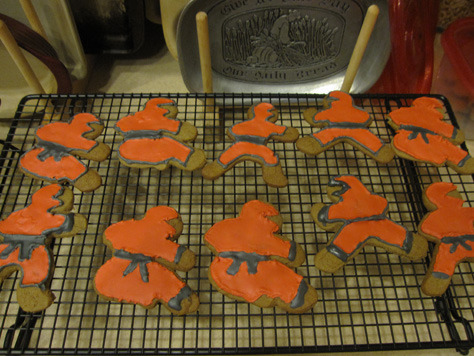
Not cool thing:
1) My plastic squeeze bottle leaked out the top where it fastened on.
Cooler thing:
2) Instead of using the bottle, I just dipped the toothpick right in the bowl, palette-style. Worked even better! Less stuff to clean, too.
In all, I'm afraid to know how many hours I spent making this one batch of cookies. However, I still have about half a batch of icing left because I'm preparing to make more cookies this weekend--including some Portal cookies for Santa. I'm not looking forward to the outlining, but I am eager to do the flooding again.
Hrm. Sounds kind of like the rough draft and revision process, actually...
To back things up a bit: I first tried royal icing two years ago. I didn't have any tips or fancy stuff--I just used a quart-size freezer bag with a corner cut off. It worked okay, though my lines were coarse and unsteady. I didn't try using any colors. I didn't try flooding. All that was too intimidating.
This year, I decided to be brave. Or stupid.

Fortunately, food bloggers exist. Real, hardcore food bloggers, who get publishing deals because of the awesomeness of their l33t cooking skillz. One such blogger is Bridget at Bake at 350, where she goes into immense detail on how to decorate cookies. She even recommends meringue and color brands. And, to the great comfort of scaredy-cats like me, she and others have videos at the University of Cookie depicting how to fill a piping bag and what the perfect consistency for flooding-icing looks like.
With all this data scrunched in my head, I set about making ninjabread men.
I used a brand new gingerbread recipe from Martha Stewart that was featured in the latest Reader's Digest. The dough tasted great, but the recipe described the dough as being very wet at the point it's formed into disc; mine was very... normal. This should have told me Something is Wrong. Because after I chilled the dough for four hours, my attempt to roll out the dough was an utter failure. It cracked and crumbled.
PANIC.
So I did what any panicking person does these days--I turned to Google. Google told me to add water by the teaspoon until the dough was malleable. Google is wise. The dough was saved. I chilled it and began my slicing and dicing ninja action. Martha Stewart advised that I chill the cookies after cutting them, and that enabled them to keep their shape while baking. I did several batches like that, and then had to let them cool completely before proceeding to the icing. Oh, the icing.
I bought my first Wilton tips, couplings, and disposable bags for this. I started out using the smallest tip for my outlining. MISTAKE. By the second cookie, my hand was already cramped and I was struggling to get the icing out. Fortunately, I bought couplings, so it was very easy to switch to a #4 tip. Much better! Even so, by the time I finished the outlining, my poor hand was tired, and I was very glad to continue with the flooding the next day.
This is where I discovered several cool things:
1) The directions at University of Cookie were excellent. It was easy to get the right consistency for flooding.
2) I LOVED flooding. It was very meditative, and reminded me of when I used to paint crafts. Really, it IS painting, just with icing and a toothpick.

Not cool thing:
1) My plastic squeeze bottle leaked out the top where it fastened on.
Cooler thing:
2) Instead of using the bottle, I just dipped the toothpick right in the bowl, palette-style. Worked even better! Less stuff to clean, too.
In all, I'm afraid to know how many hours I spent making this one batch of cookies. However, I still have about half a batch of icing left because I'm preparing to make more cookies this weekend--including some Portal cookies for Santa. I'm not looking forward to the outlining, but I am eager to do the flooding again.
Hrm. Sounds kind of like the rough draft and revision process, actually...
Published on December 21, 2012 05:00
December 19, 2012
Bready or Not: Gingerbread Bars
Some desserts are just plain dangerous because you want to EAT IT ALL.
This is one of those recipes. Consider yourself warned.
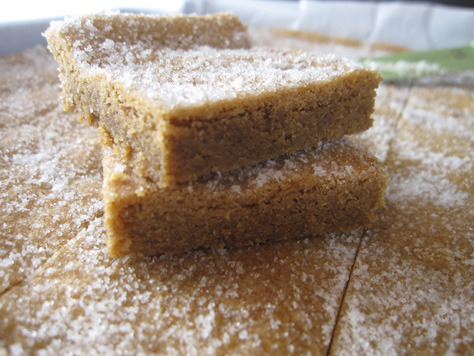
I first found this recipe back in 2003, featured on the inside of a Land O Lakes butter box. I had never been a big gingerbread fan because I associated the type with cut-out cookies, which tend to be hard. However, I gave this recipe a shot and discovered a legal, sugary equivalent to crack cocaine.
Since then, this has been a holiday favorite in my household. While this recipe can be cut into fancier shapes, I always slice it into bars. The result is a soft, luscious piece of gingerbread; the smell of it is simply divine. It's the scent of Christmas itself. Plus, it's the perfect recipe when you're low on time--it mixes together quickly and bakes in under 20 minutes. No standing around the oven for an hour, waiting for batch after batch of cookies to be done.
As soft as these bars are, they are surprisingly durable. When my husband was deployed in the Navy, I even mailed some to him overseas. I had them packed in Gladware with napkins for padding, and they survived the journey, intact and tasty.
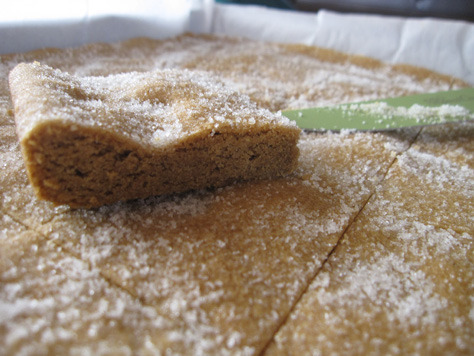
Easy Gingerbread Bars
original recipe from Land O Lakes Butter
Ingredidents:
1 1/4 cups sugar
1 cup butter, softened
1 egg
3 tablespoons molasses
3 cups all-purpose flour
1 teaspoon baking soda
2 teaspoons ground cinnamon
2 teaspoons ground ginger
2-3 tablespoons granulated sugar
Directions:
1)Preheat oven to 350-degrees.
2) Combine the 1 1/4 cups sugar, butter, egg, and molasses in a large mixer bowl and combine until creamy. Add the next four ingredients and beat until well incorporated.

3) Line a jelly roll or large bar pan with parchment paper. Press the dough evenly into pan and sprinkle granulated sugar across the top. It helps to dust it in with your fingers to make sure you get most of the nooks and crannies.
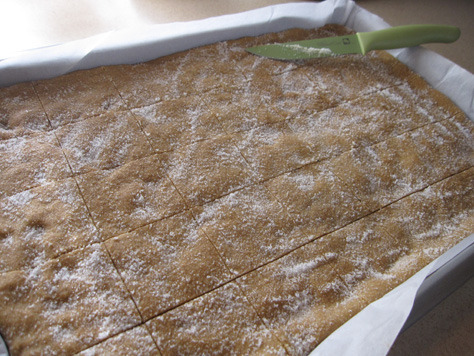
4) Bake for 16 to 20 minutes, or until very lightly browned around the edges. Cool completely. Cut into bars or other shapes. Try to resist eating them all.
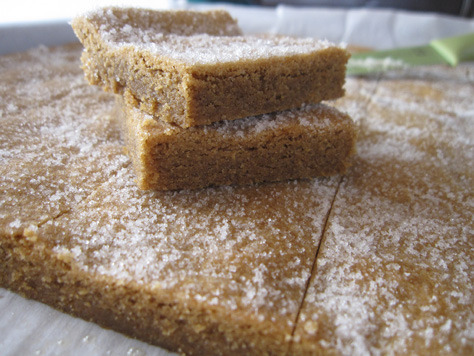
OM NOM NOM.
This is one of those recipes. Consider yourself warned.

I first found this recipe back in 2003, featured on the inside of a Land O Lakes butter box. I had never been a big gingerbread fan because I associated the type with cut-out cookies, which tend to be hard. However, I gave this recipe a shot and discovered a legal, sugary equivalent to crack cocaine.
Since then, this has been a holiday favorite in my household. While this recipe can be cut into fancier shapes, I always slice it into bars. The result is a soft, luscious piece of gingerbread; the smell of it is simply divine. It's the scent of Christmas itself. Plus, it's the perfect recipe when you're low on time--it mixes together quickly and bakes in under 20 minutes. No standing around the oven for an hour, waiting for batch after batch of cookies to be done.
As soft as these bars are, they are surprisingly durable. When my husband was deployed in the Navy, I even mailed some to him overseas. I had them packed in Gladware with napkins for padding, and they survived the journey, intact and tasty.

Easy Gingerbread Bars
original recipe from Land O Lakes Butter
Ingredidents:
1 1/4 cups sugar
1 cup butter, softened
1 egg
3 tablespoons molasses
3 cups all-purpose flour
1 teaspoon baking soda
2 teaspoons ground cinnamon
2 teaspoons ground ginger
2-3 tablespoons granulated sugar
Directions:
1)Preheat oven to 350-degrees.
2) Combine the 1 1/4 cups sugar, butter, egg, and molasses in a large mixer bowl and combine until creamy. Add the next four ingredients and beat until well incorporated.

3) Line a jelly roll or large bar pan with parchment paper. Press the dough evenly into pan and sprinkle granulated sugar across the top. It helps to dust it in with your fingers to make sure you get most of the nooks and crannies.

4) Bake for 16 to 20 minutes, or until very lightly browned around the edges. Cool completely. Cut into bars or other shapes. Try to resist eating them all.

OM NOM NOM.
Published on December 19, 2012 05:00
December 17, 2012
A Guest Post
My story behind the story of "Red Dust and Dancing Horses" has been re-published over at
 msstacy13
's blog.
msstacy13
's blog.
Dreams, Horses, and the Little Story That Could
If you're feeling down because of rejection and stubborn words, give it a read.
 msstacy13
's blog.
msstacy13
's blog.Dreams, Horses, and the Little Story That Could
If you're feeling down because of rejection and stubborn words, give it a read.
Published on December 17, 2012 08:26
December 16, 2012
Sunday Quote knows the fickle nature of cats
"Happiness is sometimes like a cat. If you try to coax it or call it, it will avoid you; it will never come. But if you pay not attention to it and go about your business, you might just find it rubbing against your legs and jumping into your lap." ~ William Bennett
Published on December 16, 2012 05:01
December 14, 2012
BONUS Bready or Not: Peppermint Bars
In the spirit of giving, I'm going to provide some bonus recipes over the next week and a half! These are all seasonal goodies that just plain demand to be posted now.
I saw these Peppermint Crumble Bars over at Something Swanky and knew I had to make them. My husband loves peppermint!
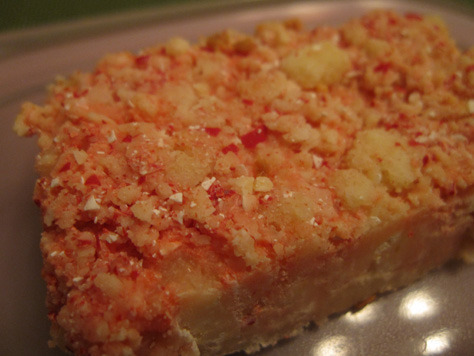
My problem: I didn't have massive quantities of candy canes or peppermints. What I did have was a bag of white chocolate peppermint M&Ms, a seasonal blend I found at Target. In my blender I coarsely chopped a whole bag's worth of M&Ms, and then I added white chocolate chips so that the total amount equaled 2 cups.
The original blog also posted a modified version of the recipe that had more crumble: 3 cups flour, 1 1/2 cups butter, and 3/4 cup sugar. When I make this again, I think I'll follow her advice and increase to those amounts (more cake coverage top and bottom), but I'm posting the original version below.
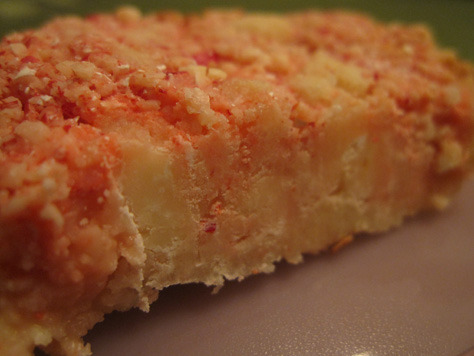
Peppermint Bars
Ingredients
- 2 cups flour
- 1 cup butter, softened
- 1/2 cup sugar
- 2 cups combined chopped mints and white chocolate (peppermint M&Ms, Andes, chocolate chips, etc)
- 1 - 14 oz can sweetened condensed milk
Instructions
Preheat oven to 350-degrees.
Use a pastry cutter or a fork to cut the butter, sugar, and flour together until crumbly. (Using a mixer is really overkill.)
Press a little more than half of the crumble mixture into the bottom of a greased 9x13 lined baking dish.
In a medium saucepan over low heat, mix 1 cup of the white chocolate peppermint candy and the sweetened condensed milk until smooth. Pour over the crumb crust in the dish.
Sprinkle the remaining crumble and white chocolate peppermint mix evenly over top.
Bake for 20 minutes or until edges begin to just barely brown.
Let cool completely before cutting into squares. [Note: I live in Arizona where it's warm, so I had to keep these refrigerated to stay set.]
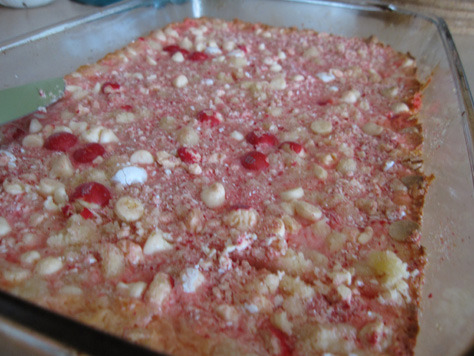
OM NOM NOM.
I saw these Peppermint Crumble Bars over at Something Swanky and knew I had to make them. My husband loves peppermint!

My problem: I didn't have massive quantities of candy canes or peppermints. What I did have was a bag of white chocolate peppermint M&Ms, a seasonal blend I found at Target. In my blender I coarsely chopped a whole bag's worth of M&Ms, and then I added white chocolate chips so that the total amount equaled 2 cups.
The original blog also posted a modified version of the recipe that had more crumble: 3 cups flour, 1 1/2 cups butter, and 3/4 cup sugar. When I make this again, I think I'll follow her advice and increase to those amounts (more cake coverage top and bottom), but I'm posting the original version below.

Peppermint Bars
Ingredients
- 2 cups flour
- 1 cup butter, softened
- 1/2 cup sugar
- 2 cups combined chopped mints and white chocolate (peppermint M&Ms, Andes, chocolate chips, etc)
- 1 - 14 oz can sweetened condensed milk
Instructions
Preheat oven to 350-degrees.
Use a pastry cutter or a fork to cut the butter, sugar, and flour together until crumbly. (Using a mixer is really overkill.)
Press a little more than half of the crumble mixture into the bottom of a greased 9x13 lined baking dish.
In a medium saucepan over low heat, mix 1 cup of the white chocolate peppermint candy and the sweetened condensed milk until smooth. Pour over the crumb crust in the dish.
Sprinkle the remaining crumble and white chocolate peppermint mix evenly over top.
Bake for 20 minutes or until edges begin to just barely brown.
Let cool completely before cutting into squares. [Note: I live in Arizona where it's warm, so I had to keep these refrigerated to stay set.]

OM NOM NOM.
Published on December 14, 2012 10:36
December 12, 2012
Bready or Not: Snickerdoodles
Cookie Month continues with a recipe that's both sentimental and delicious.
When I was eight or nine, I went along with my grandma on a visit to an old friend of hers, Ruby. They jabbered and talked and I lurked around the table. Ruby had a plate of cookies out on the table, and they were the most amazing, magical cookies--rolled in cinnamon and sugar, soft and chewy all at once. I was awed.
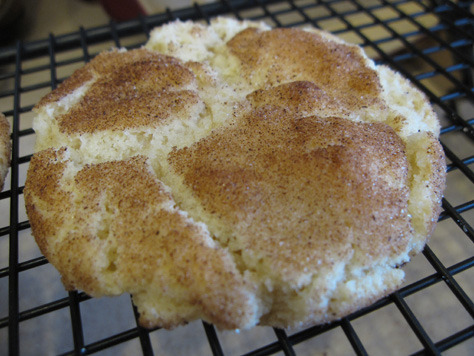
A few weeks later, Grandma presented me with a special gift. "Ruby sent you the recipe for those cookies," she said, handing me a paper clipped from a Gold Medal Flour bag.
This was my first recipe.
I didn't attempt making it until years later, when I was fourteen, and then I struggled with it for a few years after that. I was dreadfully afraid of under-baking the cookies, so I baked too long to compensate. Basically, I created cinnamon and sugar-dusted hockey pucks. It took me time to realize that I should let the cookies sit on the sheet for five or ten minutes--that they are still cooking at that point--and then they will be firm enough to move to a rack.
Snickerdoodles taught me how to bake. Now, maybe you can share in some cinnamon-sweet joy this holiday season.
Snickerdoodles
Recipe from Gold Medal Flour, from the late 1980s.
Ingredients:
1 ½ cups sugar
½ cup margarine or butter, softened
½ cup shortening
2 eggs
2 ¾ cups all-purpose flour
2 teaspoons cream of tartar
1 teaspoon baking soda
¼ teaspoon salt
--
3 tablespoons sugar
3 teaspoons ground cinnamon
Directions:
Heat oven to 400-degrees.
Mix the 1 ½ cups sugar, butter or margarine, shortening and eggs in a large bowl. Stir in flour, cream of tartar, baking soda and salt. Shape dough by rounded teaspoonfuls into balls.
Combine 3 tablespoons sugar and the cinnamon; roll balls in mixture. Place about 2 inches apart on an ungreased cookie sheet. Bake 8 to 10 minutes; when they are done, the tops will have cracks. If they are turning golden at the edges, take them out fast--they are over-baked! Let them sit on the cookie sheet about 5-10 minutes to set before moving to a rack.
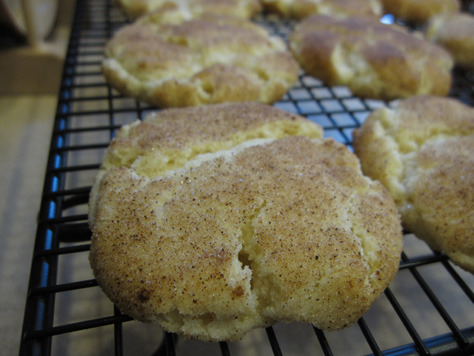
OM NOM NOM.
When I was eight or nine, I went along with my grandma on a visit to an old friend of hers, Ruby. They jabbered and talked and I lurked around the table. Ruby had a plate of cookies out on the table, and they were the most amazing, magical cookies--rolled in cinnamon and sugar, soft and chewy all at once. I was awed.

A few weeks later, Grandma presented me with a special gift. "Ruby sent you the recipe for those cookies," she said, handing me a paper clipped from a Gold Medal Flour bag.
This was my first recipe.
I didn't attempt making it until years later, when I was fourteen, and then I struggled with it for a few years after that. I was dreadfully afraid of under-baking the cookies, so I baked too long to compensate. Basically, I created cinnamon and sugar-dusted hockey pucks. It took me time to realize that I should let the cookies sit on the sheet for five or ten minutes--that they are still cooking at that point--and then they will be firm enough to move to a rack.
Snickerdoodles taught me how to bake. Now, maybe you can share in some cinnamon-sweet joy this holiday season.
Snickerdoodles
Recipe from Gold Medal Flour, from the late 1980s.
Ingredients:
1 ½ cups sugar
½ cup margarine or butter, softened
½ cup shortening
2 eggs
2 ¾ cups all-purpose flour
2 teaspoons cream of tartar
1 teaspoon baking soda
¼ teaspoon salt
--
3 tablespoons sugar
3 teaspoons ground cinnamon
Directions:
Heat oven to 400-degrees.
Mix the 1 ½ cups sugar, butter or margarine, shortening and eggs in a large bowl. Stir in flour, cream of tartar, baking soda and salt. Shape dough by rounded teaspoonfuls into balls.
Combine 3 tablespoons sugar and the cinnamon; roll balls in mixture. Place about 2 inches apart on an ungreased cookie sheet. Bake 8 to 10 minutes; when they are done, the tops will have cracks. If they are turning golden at the edges, take them out fast--they are over-baked! Let them sit on the cookie sheet about 5-10 minutes to set before moving to a rack.

OM NOM NOM.
Published on December 12, 2012 05:00
December 11, 2012
Awards Season
It's that time of year when candy canes are stacked in every store, and fantasy and science fiction writers look to 2013 and the Nebula and Hugo Awards. This is the first year I'm really making a full effort to promote my work. In particular, I am sending out "Red Dust and Dancing Horses" and "Overlap."
If you're reading for either award, please feel free to email me at beth.l.cato at gmail dot com, and I can send you the files directly; or, they can be downloaded in the SFWA forums or on Codex Writers in the docs section.
- "Overlap," Cucurbital 3; doc, rtf, and pdf for SFWA members
- "Blue Tag Sale,"; Buzzy Mag
- "Cartographer's Ink," Daily Science Fiction
- "Red Dust and Dancing Horses," Stupefying Stories Issue 1.5 (March 2012); available in epub, mobi, and pdf for SFWA members
If you're reading for either award, please feel free to email me at beth.l.cato at gmail dot com, and I can send you the files directly; or, they can be downloaded in the SFWA forums or on Codex Writers in the docs section.
- "Overlap," Cucurbital 3; doc, rtf, and pdf for SFWA members
- "Blue Tag Sale,"; Buzzy Mag
- "Cartographer's Ink," Daily Science Fiction
- "Red Dust and Dancing Horses," Stupefying Stories Issue 1.5 (March 2012); available in epub, mobi, and pdf for SFWA members
Published on December 11, 2012 06:54
December 9, 2012
Sunday Quote gets advice from a hockey great
"You've got to love what you're doing. If you love it, you can overcome any handicap or the soreness or all the aches and pains, and continue to play for a long, long time." ~Gordie Howe
Published on December 09, 2012 05:01



